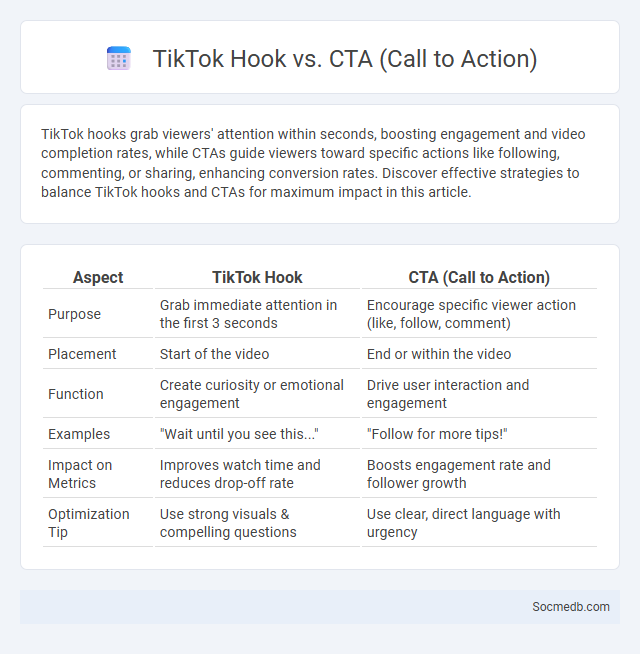
Photo illustration: TikTok Hook vs CTA (Call to Action)
TikTok hooks grab viewers' attention within seconds, boosting engagement and video completion rates, while CTAs guide viewers toward specific actions like following, commenting, or sharing, enhancing conversion rates. Discover effective strategies to balance TikTok hooks and CTAs for maximum impact in this article.
Table of Comparison
| Aspect | TikTok Hook | CTA (Call to Action) |
|---|---|---|
| Purpose | Grab immediate attention in the first 3 seconds | Encourage specific viewer action (like, follow, comment) |
| Placement | Start of the video | End or within the video |
| Function | Create curiosity or emotional engagement | Drive user interaction and engagement |
| Examples | "Wait until you see this..." | "Follow for more tips!" |
| Impact on Metrics | Improves watch time and reduces drop-off rate | Boosts engagement rate and follower growth |
| Optimization Tip | Use strong visuals & compelling questions | Use clear, direct language with urgency |
Understanding Hooks: The Power of First Impressions
Understanding hooks on social media is crucial for capturing your audience's attention within seconds, as first impressions determine whether users engage or scroll past your content. Crafting compelling hooks involves using strong, relatable language and visually appealing elements that resonate with your target demographic and align with platform-specific trends. Your ability to create memorable and impactful hooks boosts content visibility, increases engagement rates, and ultimately drives meaningful interactions.
What is a CTA (Call to Action) in TikTok Content?
A CTA (Call to Action) in TikTok content is a directive that encourages viewers to engage with the video, such as liking, commenting, sharing, or following the creator's account. Effective CTAs on TikTok increase user interaction, boost video visibility through the platform's algorithm, and drive specific outcomes like website visits or product purchases. Including clear, concise CTAs enhances content performance and supports creators in achieving marketing objectives on TikTok.
TikTok Hook vs. Traditional Hook: Key Differences
TikTok hooks capture attention within the first 2-3 seconds using dynamic visuals, trending sounds, and direct engagement to quickly draw viewers in, unlike traditional hooks that rely on slower-building narratives or text-based introductions. Your content on TikTok must be concise and visually captivating to stand out in a fast-scrolling environment, whereas traditional media often allows for more detailed storytelling before delivering the key message. Understanding these differences helps optimize your marketing strategy for maximum impact across platforms.
Why Hooks Matter for TikTok Engagement
Hooks are crucial for TikTok engagement because they capture Your audience's attention within the first few seconds, increasing the likelihood of views and shares. Effective hooks improve watch time, signaling TikTok's algorithm to promote Your content to a broader audience. Crafting compelling hooks enhances user interaction, driving comments, likes, and follower growth on the platform.
The Role of CTAs in Growing Your TikTok Audience
Calls-to-action (CTAs) significantly boost TikTok audience growth by encouraging viewers to like, comment, share, or follow, increasing engagement rates and visibility. Optimized CTAs tailored to TikTok's short-video format drive user interaction, promoting algorithmic favorability and organic reach. Data shows videos with clear CTAs receive up to 20% higher engagement, accelerating follower acquisition and enhancing brand presence.
Combining Hooks and CTAs for Maximum Impact
Combining compelling hooks with clear calls-to-action (CTAs) significantly boosts audience engagement and conversion rates on social media platforms. Effective hooks capture attention within seconds by addressing pain points or sparking curiosity, while strategic CTAs guide users toward specific actions such as clicking links, sharing content, or making purchases. Harnessing data-driven insights to tailor hooks and CTAs increases click-through rates and enhances overall campaign performance across Facebook, Instagram, and Twitter.
Crafting Effective Hooks for TikTok Videos
Crafting effective hooks for TikTok videos requires understanding your target audience's interests and behavior patterns to capture attention within the first 2-3 seconds. Use compelling visuals, bold text overlays, and provocative questions to spark curiosity and encourage viewers to stay engaged. Your hook sets the tone for the entire video, making it essential to optimize this element for higher retention and increased reach on TikTok's algorithm.
CTA Strategies That Work on TikTok
Effective CTA strategies on TikTok include using clear, concise commands like "Tap the link" or "Follow for more" to drive engagement. Leveraging TikTok's interactive features such as polls, challenges, and hashtags encourages user participation and boosts visibility. Tailoring your CTAs to match TikTok's fast-paced, visually-driven content increases the likelihood that Your audience will take immediate action.
Common Mistakes: Overusing Hooks or CTAs
Overusing hooks or calls-to-action (CTAs) in social media content can overwhelm your audience, reducing engagement and trust. Instead of compelling your followers, excessive hooks create a sense of pushiness that leads to content fatigue. To maximize impact, use hooks and CTAs strategically, ensuring your message remains valuable and resonates with your audience's needs.
Best Practices: Balancing Hook and CTA in TikTok Content
Maximize TikTok engagement by crafting content that balances a captivating hook with a clear call-to-action (CTA) to guide viewers seamlessly from interest to interaction. Use attention-grabbing visuals and concise messaging within the first 3 seconds to retain viewers, then incorporate a CTA tailored to your brand goals, such as liking, sharing, or following for more. Your content's success depends on maintaining this equilibrium, ensuring the audience is both intrigued and motivated to engage.
 socmedb.com
socmedb.com